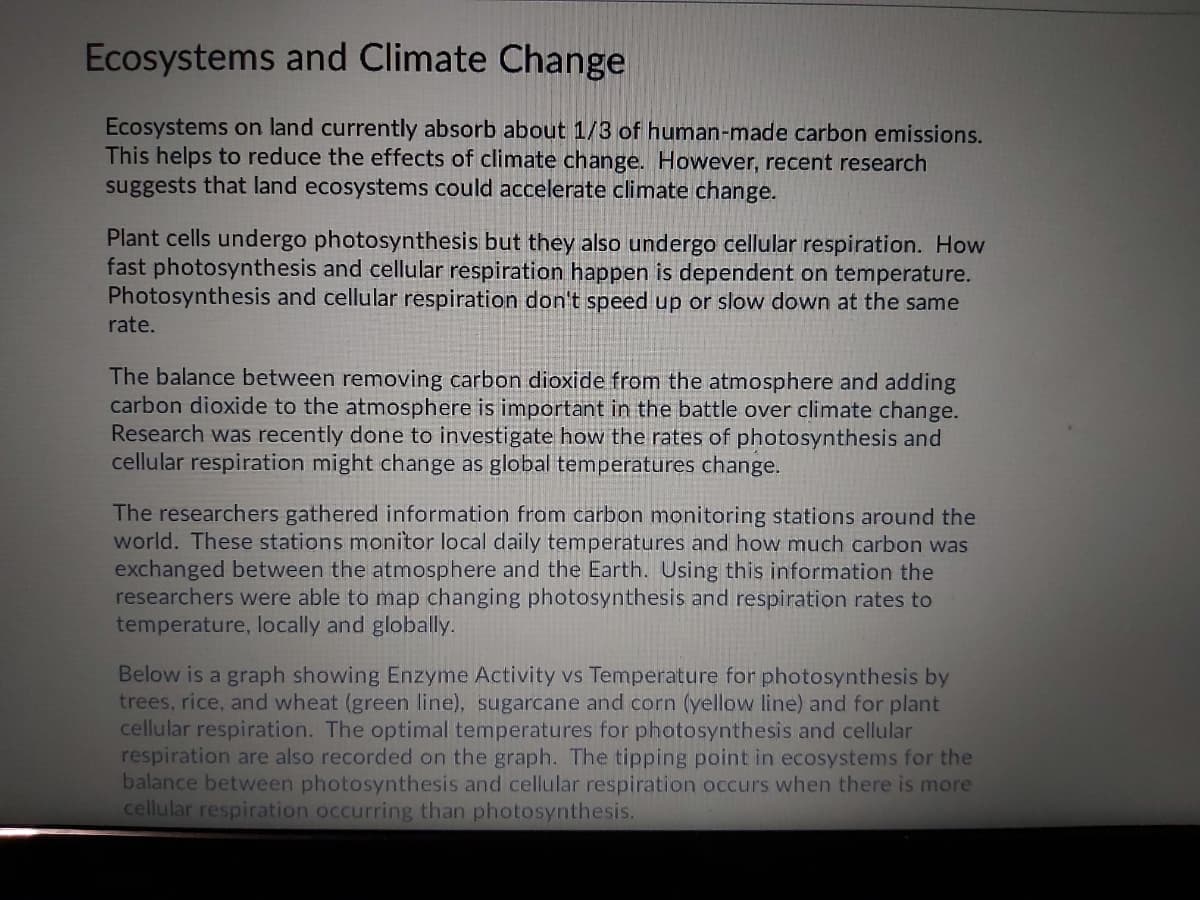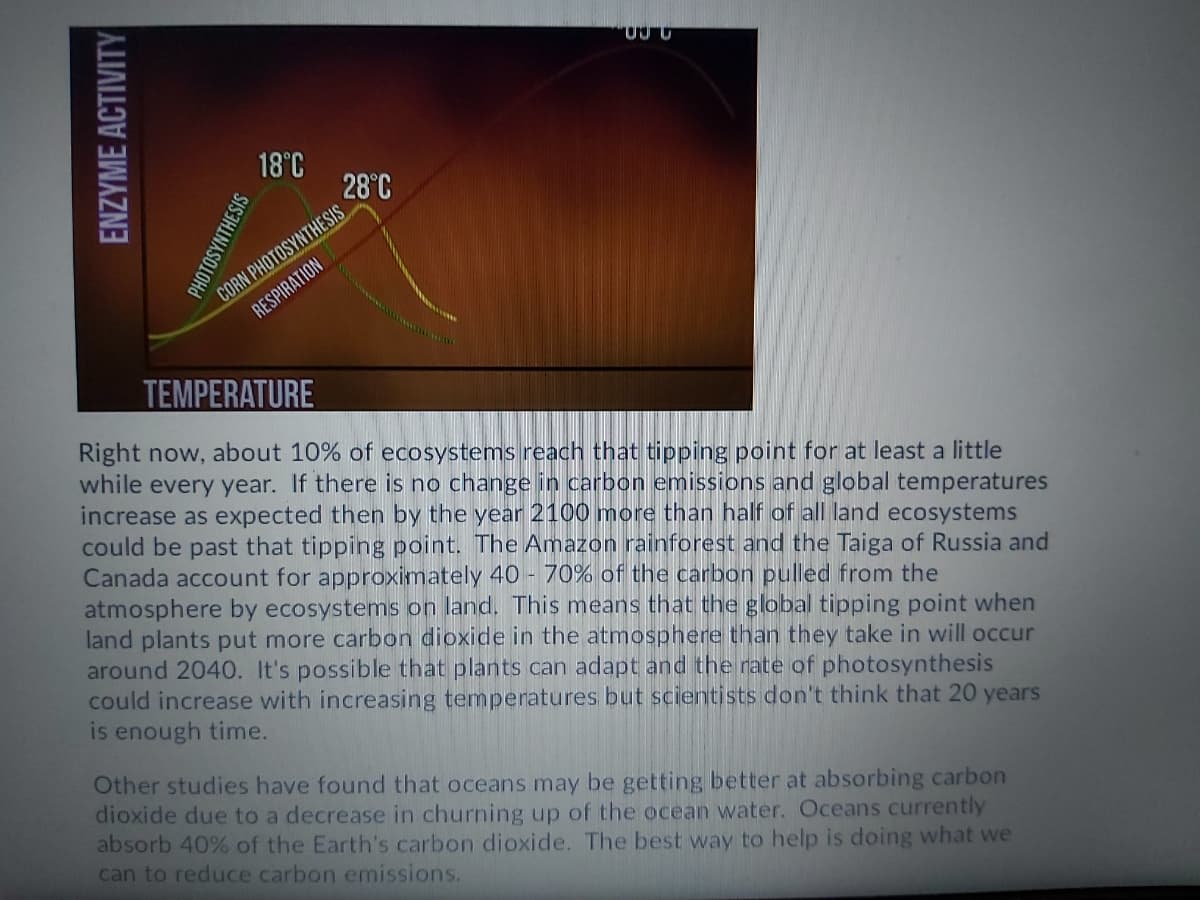Biochemistry
6th Edition
ISBN:9781305577206
Author:Reginald H. Garrett, Charles M. Grisham
Publisher:Reginald H. Garrett, Charles M. Grisham
Chapter21: Photosynthesis
Section: Chapter Questions
Problem 14P: The Source of the Oxygen Atoms in Photosynthetic O2 Evolution The overall equation for...
Related questions
Question
Provide the balanced chemical reaction for cellular respiration .

Transcribed Image Text:Ecosystems and Climate Change
Ecosystems on land currently absorb about 1/3 of humnan-made carbon emissions.
This helps to reduce the effects of climate change. However, recent research
suggests that land ecosystems could accelerate climate change.
Plant cells undergo photosynthesis but they also undergo cellular respiration. How
fast photosynthesis and cellular respiration happen is dependent on temperature.
Photosynthesis and cellular respiration don't speed up or slow down at the same
rate.
The balance between removing carbon dioxide from the atmosphere and adding
carbon dioxide to the atmosphere is important in the battle over climate change.
Research was recently done to investigate how the rates of photosynthesis and
cellular respiration might change as global temperatures change.
The researchers gathered information from carbon monitoring stations around the
world. These stations monitor local daily temperatures and how much carbon was
exchanged between the atmosphere and the Earth. Using this information the
researchers were able to map changing photosynthesis and respiration rates to
temperature, locally and globally.
Below is a graph showing Enzyme Activity vs Temperature for photosynthesis by
trees, rice, and wheat (green line), sugarcane and corn (yellow line) and for plant
cellular respiration. The optimal temperatures for photosynthesis and cellular
respiration are also recorded on the graph. The tipping point in ecosystems for the
balance between photosynthesis and cellular respiration occurs when there is more
cellular respiration occurring than photosynthesis.

Transcribed Image Text:18°C
28°C
CORN PHOTOSYNTHESIS
RESPIRATION
TEMPERATURE
Right now, about 10% of ecosystems reach that tipping point for at least a little
while every year. If there is no change in carbon emissions and global temperatures
increase as expected then by the year 2100 more than half of all land ecosystems
could be past that tipping point. The Amazon rainforest and the Taiga of Russia and
Canada account for approximately 40 - 70% of the carbon pulled from the
atmosphere by ecosystems on land. This means that the global tipping point when
land plants put more carbon dioxide in the atmosphere than they take in will occur
around 2040. It's possible that plants can adapt and the rate of photosynthesis
could increase with increasing temperatures but scientjsts don't think that 20 years
is enough time.
Other studies have found that oceans may be getting better at absorbing carbon
dioxide due to a decrease in churning up of the ocean water. Oceans currently
absorb 40% of the Earth's carbon dioxide. The best way to help is doing what we
can to reduce carbon emissions.
ENZYME ACTIVITY
PHOTOSYNTHESIS
Expert Solution
This question has been solved!
Explore an expertly crafted, step-by-step solution for a thorough understanding of key concepts.
Step by step
Solved in 2 steps

Knowledge Booster
Learn more about
Need a deep-dive on the concept behind this application? Look no further. Learn more about this topic, biology and related others by exploring similar questions and additional content below.Recommended textbooks for you

Biochemistry
Biochemistry
ISBN:
9781305577206
Author:
Reginald H. Garrett, Charles M. Grisham
Publisher:
Cengage Learning

Biology 2e
Biology
ISBN:
9781947172517
Author:
Matthew Douglas, Jung Choi, Mary Ann Clark
Publisher:
OpenStax


Biochemistry
Biochemistry
ISBN:
9781305577206
Author:
Reginald H. Garrett, Charles M. Grisham
Publisher:
Cengage Learning

Biology 2e
Biology
ISBN:
9781947172517
Author:
Matthew Douglas, Jung Choi, Mary Ann Clark
Publisher:
OpenStax


Biology Today and Tomorrow without Physiology (Mi…
Biology
ISBN:
9781305117396
Author:
Cecie Starr, Christine Evers, Lisa Starr
Publisher:
Cengage Learning

Concepts of Biology
Biology
ISBN:
9781938168116
Author:
Samantha Fowler, Rebecca Roush, James Wise
Publisher:
OpenStax College